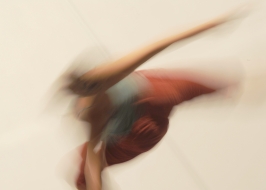Gadi Dagon"Digital Dancer"Raoul and Graziella de Picciotto Building for Scientific and Technical Support1
Gadi Dagon dances. For those who know him, this may seem a bit strange. But on second thought, it's not surprising in the least. When he was immersed in sports photography, he showed up one day with a portrait of himself in boxing gloves, with a crushed nose and blood trickling down his cheeks to his chin. Bodily fluids are not foreign to him. Once he shared the bloodiness of his sports subjects. As the Batsheva Dance group's photographer, he shares the dancers' sweat – and sometimes also their tears.
In the world of photography, there is one boundary – one that is generally thought to be impassable. That boundary is the camera itself, which separates those standing in front of the lens and those who seek protection behind it. The ability to be simultaneously on both sides of the boundary is something like both locking a drawer and leaving the key inside. Gadi Dagon has uncovered the secret of being there on the stage – or more precisely, leaving his mark on it, even though he is observing it from a distance.
He previous works are testimony to Dagon’s continual attempts to tear down the invisible wall between the photographer and the photographed. At that time, the boundary stubbornly continued to divide the two worlds. Until, that is, the advent of digital photography, which led him to the breakthrough he had long been seeking.
Dagon switches the camera to manual and sets it to a relatively slow exposure. This mode enables him to dance with the camera, tracing the footsteps of the dancers. With movement, in the places where the lens lingers longer, it gathers more light or, if you like, the camera’s sensor captures more information. The places Dagon moves through relatively quickly acquire a certain transparency. By means of alternating rapid and slow movements, he creates a gradation that is reminiscent of the effect achieved in standard photography through repeated exposures. Thus the photographer, by mastering both the dancers' body language and the camera's physical attributes – paints a digital picture that is his interpretation of the dance.
Gadi Dagon dances. He dances behind the scenes or at a window overlooking the stage. But he shows us his dance, documented by the camera he is holding while he dances. The camera's lens is directed toward Batsheva's dancers, but for those observing photographs, the photographer's dance movements can be traced.
Gadi Dagon is the digital dancer.
Curator: Yivsam Azgad







